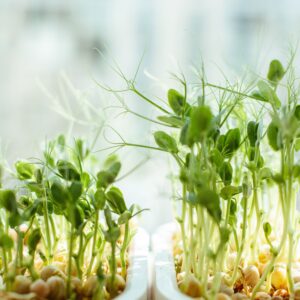Introduction:
[Sprouts]Fermented foods have gained popularity for their probiotic benefits and taste as well. These have biologically active compounds which affect gastrointestinal health. Some beneficial and popularly used fermented plant foods are kefir, sauerkraut, kombucha tempeh, miso, kimchi, natto, and sourdough bread. Sprouted grains are soaked until their sprouts start, boosting the grain’s nutrition levels and enhancing the taste.

Sprouts plant foods
There are various types of sprouted plant food coming from different types of sources. Bean sprouts come from beans like lentils, green peas, kidney beans, and soybean. Sprouted grains come from brown rice, buckwheat, quinoa, whole wheat, and oat sprouts. Vegetable sprouts come from vegetables like beet, broccoli, radish, and fenugreek sprouts. Nuts and seed sprouts come from almonds, sesame, pumpkin seeds, and more.
Sprouting is the germination process in a certain period. The grains or nuts are soaked in water and germinate for a couple of days which are then consumed with salads or other food. They can be consumed raw or sometimes cooked as well.Some sprouted foods like broccoli and almond sprouts are nutrient dense. Sprouting or soaking also makes grains easier to digest. Broccoli sprouts are loaded with protein, calcium, fiber, vitamin A and C.
It is also a good source of antioxidants called sulforaphane. A mini sprout garden can be created at home, and these plant foods can be enjoyed fresh regularly. These have lower sugar levels and are safe to consume daily. These also help with weight management or obesity and diabetes.

Fermented plant foods
Fermented foods are as old as 7000 BC in China. It was a means of preserving different types of food for longer periods. There are fermented foods in different parts of the world, mainly in China, Korea, and Japan. For example, Korea is famous for Kimchi, and Japan for natto (fermented soybean).
From ancient times fermentation was a method to preserve food which was found to produce unique compounds, lactic acid, and antimicrobial peptides. The growth of pathogenic microorganisms prevented the food from spoiling during fermentation. Eventually, the enhanced taste and nutritional benefits were found. This is an ancient culture or nutrition passed and consumed till today through generations.
Let’s look at some of the widely used fermented foods and their benefits:
1. Kimchi
This is a Korean dish widely used in many parts of the world. Cabbage and other vegetables are used and fermented to make kimchi. The probiotic and nutrient-rich plant food is spicy and tangy. This is good for gut health and helps improve blood sugar and cholesterol levels and control blood pressure.
2. Kombucha
Kombucha is a tea that is green or black and is also flavored with herbs or fruit. This is an effervescent tea that is rich in bacteria and yeast with little alcohol content as well. The alcohol content is around 0.5 percent for fermentation. This is unique for its sour taste and is available in many grocery stores or markets. This is a good source of lactic acid, acetic acid bacteria, and yeast, but there are no clear effects on human or gastrointestinal health.
3. Sauerkraut
Sauerkraut is made with shredded cabbage and fermented with lactic acid bacteria. It contains antioxidants like lutein and zeaxanthin with vitamin C and vitamin K. It is high in fiber but low in calories and is used in multiple dishes like sandwiches and soups. The presence of antioxidants helps prevent cancer and also treats breast cancer cells.
4. Soya Products (Tempeh, Miso, Natto)
- Tempeh
Tempeh is made with soybeans and is a popular traditional food. A starter culture of Rhizopus oligosporus is used to make this. Boiled and dehulled soybeans are fermented at room temperature for about 35-37 hours. Tempeh looks like a soft white cake and is chewy in texture. It can be baked, steamed, or sauteed and used in different recipes. It is high in probiotics and antioxidants, making it beneficial for heart health. It is also a good source of vegetarian protein and amino acids.
- Natto
Nato is a traditional breakfast that originated in Japan. It is fermented with Bacillus subtilis var., which makes it pungent and flavorful. It is mainly made from fermented soybean. A lot of beneficial factors are produced due to fermentation, such as bacillopeptidase F, dipicolinic acid, nattokinase, and vitamin K2, which are bioactive factors and beneficial for health. Nato affects bowel motions and influences gastrointestinal microbiota.
- Miso
Miso is unique for umami flavor and is made from soybeans, rice, or barley. It is popularly used in salad dressings, soups, and marinades. A paste is made from rice, barley, or soybeans fermented to make miso. A lot of essential vitamins like zinc, vitamin K, manganese, protein, and calcium are present in miso.
5. Sourdough Bread
Lactic acid bacteria and yeast is used as a starter to ferment flour for sourdough. The sourdough starter needs about 7 days and involves a process for better results. Backslopping is the process where the starter is applied to initiate the fermentation process of sourdough. This is anti-microbial and helps reduce cholesterol levels.

Conclusion
Sprouts and fermented plant foods add taste and nutritional value to our food. These are also helpful in adding multiple health benefits and avoiding diseases. It helps in weight management, protects against toxins, and improves heart health. many fermented plant foods help and support gut health or aid digestion. Adding these in moderate quantities is always good, and enjoying the benefits.
These are very popular in the culinary world for their unique taste and flavor. The Japanese and Korean cuisines are also well known for some of these foods which are now enjoyed worldwide.
Internal links:
Portable Food, Sandwich- Erakina
Zucchette Pasta: An appetizing Fall Comfort Food
External links:
Date: 20/07/2022






